How to close up a fistula in a sewer pipe with your own hands. How to seal a fistula with a repair clamp with a rubber gasket for water pipes
One of the most common problems that occur in a metal riser for water supply and heating is the formation of a fistula.
Most often, a fistula appears on hot water pipes. Determining this problem is quite simple: in the place where the fistula forms, a red growth or pitting appears.
The reason for the appearance of a fistula on a metal pipe is wear. However, when this problem appears, it is necessary to think not about the reasons, but about rational ways that will avoid a pipe break.
Before proceeding with the solution of the problem that has arisen, it is necessary to drain the water from the system by closing the stop valve and opening all taps. After that, you can choose one of the acceptable methods.
This method is not suitable for old pipes, as it involves threading, and old pipes are not suitable for this operation, which can simply increase the diameter of the leak. If you plan to repair new pipes, then you have to do the following:
- take a drill and expand the fistula;
- make a thread with a tap;
- screw the bolt into the threaded hole.
Method two: installing a temporary bandage
This method is intended for sealing an oblong fistula. To apply a bandage, you need to stock up on a rubber pad, which can be made from improvised means: rubber from a boot, tourniquet, tire or thick rubber glove.
In size, such a gasket should be larger than the fistula. To tightly fix the gasket on the pipe, you can use either bolts or special clamps.
Method three: elimination of the fistula with an adhesive bandage
In this case, the work process consists of several stages.
First stage. Clean the surface of the riser from dirt using a metal brush. Then treat it with gasoline. Allow the pipe to dry after processing. This will take fifteen minutes.
Second phase. Take fiberglass and cut into strips. The size of the segments should be such that one strip can wrap the pipe six times. And the width of the tape should be greater than the diameter installed pipe by one third.
Third stage. Treat the edge of the resulting strip with BF-2 glue. Then apply epoxy glue to one side with a spatula. The adhesive must completely saturate the material.
Fourth stage. After that, a tape is wound around the water pipe, the central part of which should completely cover the damage site.
Fifth stage. The resulting bandage must be pulled off and secured with a strip of metal tape.
It is important to remember that you can use the pipe after repair after one day, if it is located in warm room. If the temperature in the room does not exceed seventeen degrees Celsius, then the riser can be operated only after four days.
Method four: cold welding and fistula repair
For temporary sealing of the fistula, cold welding is also used. In this case, it is necessary to make the fistula wider with a drill, treat the pipe with acetone, after cleaning it, and apply the prepared composition, which will harden in ten minutes.
What to do with the old pipe?
Old pipes can also be eliminated from fistulas with the help of clamps, the diameter of which should correspond to the diameter of the pipe. In addition, it is necessary to cut rubber bands that will be placed under the clamps.
This method is very convenient to use when the fistula appears suddenly at the wrong time of day. In order not to flood the neighbors before the arrival of the emergency team, it is this design that is best used.
If the fistula is small, then a car clamp will do. standard size. The repair process is as follows:
- cut out the rubber band. Its width should be either more than three to four millimeters of the damage site, or equal to it. The length is determined by winding the tape around the pipe;
- open the clamp and put it on the damaged place;
- lightly grab the clamp and insert the cut out rubber gasket, gently bringing it to the place where the fistula formed;
- we close the damaged place and fix the clamp with a key or a screwdriver.
If the damage is large, then a clamp of the appropriate size will be required. To install it, it is necessary to drain the water from the pipes, after turning off the water supply.
Before installing the clamp, it is necessary to find out the condition of the pipe. All irregularities must be cleaned with sandpaper, otherwise the water will ooze along the resulting irregularities. Then the clamp is installed in the manner described above.
In principle, sealing a fistula in a metal pipe is not very difficult. This task can be easily handled if you have the most common tools and materials at hand. Experienced craftsmen recommend preparing the necessary materials in advance if you have metal risers installed in your apartment or house. Then no leak will take you by surprise.
The article below will help you independently resolve the issue of sealing fistulas on pipes. The problem of how to close a fistula in a pipe under pressure is really very relevant.
After all, a leak in the pipes of the water supply, heating, drain can occur at the most inopportune moment, and it must be solved quickly and efficiently.
First of all, it is necessary to understand that all the proposed tips are interesting, but, unfortunately, they are not long-term, and the results in the future could be much worse.
Not only are they not expensive, but they are also easy to install. Their installation is not complicated, and it is easy to do it yourself.
When talking about methods of sealing leaks, a "breakthrough" of a small scale is meant. If water breaks through with a fountain, then there is only one way out - replacing the pipeline.
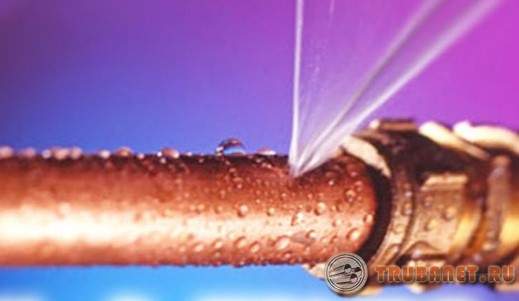 They call it a fistula pitting, which is formed from partial destruction of the material, or from general old age. The result is a hole through which the liquid flows out.
They call it a fistula pitting, which is formed from partial destruction of the material, or from general old age. The result is a hole through which the liquid flows out.
The external visual manifestation of the fistula is swollen paint and rust outgrowths. Seeing such a growth, one should not rush to rip it off, because the size of the damage under it is not predictable.
In general, fixing pitting is not hard work, but, nevertheless, it is also necessary to prepare seriously for it.
For such events you will need (experts say that you must always have on hand):
- Clamp (a couple of pieces).
- Rubber pads (these are easy to make from any materials at hand such as old boots, thick rubber gloves, a bicycle tire, and so on).
- Screwdriver and bolts.
- Epoxy materials.
- Degreasing fluid.
- Emery.
- Cold welding.
Causes of fistulas on water pipe, often reduced to the same denominator. This impact corrosion.
The most suitable temperature indicator for corrosive formations is +15 degrees. Most often, pipe materials in this mode are found in spring, summer and autumn.
It also accelerates corrosion damage and water located in the system. Over time, inside metal pipelines grow rust.
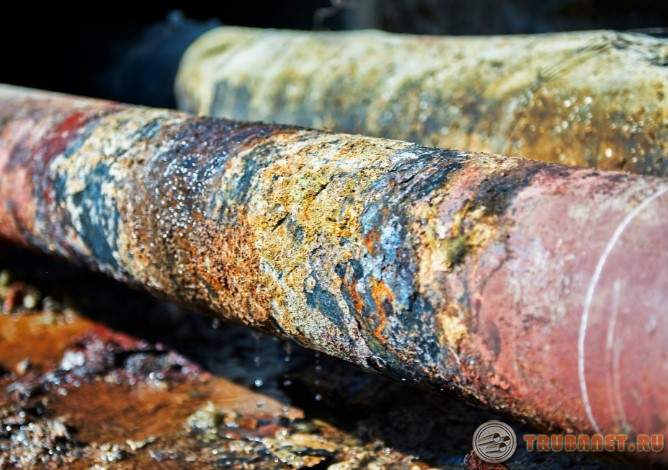
The metal in such products becomes thinner every year. And here comes the moment when corrosion breaks through the wall completely. As a result, a leak is formed.
When a small fistula occurs, the water slowly flows down the pipeline, where a puddle subsequently forms.
It is necessary to eliminate this problem immediately, without waiting until it turns into a big nuisance. If the leak is small, then it can be sealed under pressure without turning off the water supply.
Leaks in various systems
Fistula in the pipe with hot water or any other system that consists of metal pipes can be quickly sealed in the following ways:
 Option 1. Medical bandage and cement mortar. It is cut into pieces, soaked in a previously prepared cement mortar. These bandages are wound around the leakage zone, forming a cocoon-like structure.
Option 1. Medical bandage and cement mortar. It is cut into pieces, soaked in a previously prepared cement mortar. These bandages are wound around the leakage zone, forming a cocoon-like structure.
In conclusion, the resulting structure is also covered with a cement mortar. It dries out in about one day.
Option 2. Pieces of rubber. The rubber is cut into strips. Each of them should be slightly longer than the circumference of the pipe.
Option 3. Edible salt and bandage. As a rule, this method is used to seal leaks under pressure in couplings, elbows, etc. The leaking area is wrapped with a bandage mixed with salt.
When dissolved, the salt fixes a microleakage. If we compare this method of sealing under pressure, then it is immediately worth noting that it is not as reliable as the first two.
Option 4. Bandage. This method can be used for pressure pipes. The bandage is one of the oldest and most proven options. A small car clamp can be applied to a fistula with a volume of up to 0.005 cm3.

For the clamp, a strip of rubber is cut out, a couple of millimeters wider than the clamp itself. The length of the strip must be one centimeter shorter than the circumference of the pipeline. .
All this construction is obliged to completely cover the fistula. Next, the clamp is tightened. With these measures, the surface at the site of corrosion must be cleaned.
Video: ways to close a fistula
It should not contain irregularities. If this is not done, then the liquid will pass through the bandage in the area of uneven zones.
Seal fistula in plastic pipelines
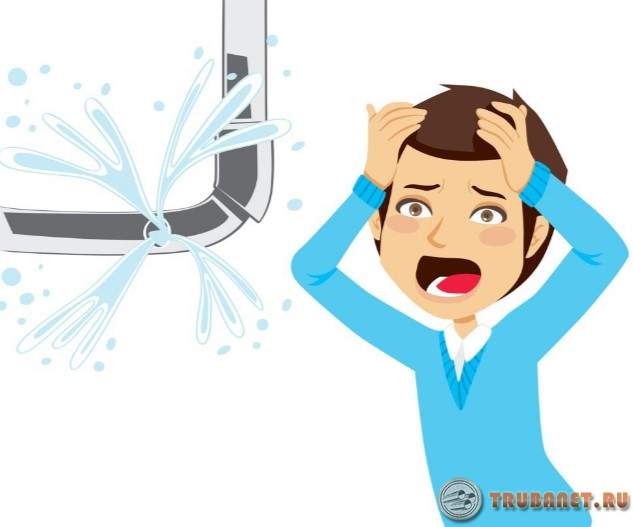 How to eliminate a fistula in a water pipe if it is made of plastic. in recent times are used very often.
How to eliminate a fistula in a water pipe if it is made of plastic. in recent times are used very often.
They quickly replaced the usual steel products, thanks to a wide range of positive characteristics. These materials are not only easy to install, but also easy to repair when fistulas appear.
You can repair a leak on a plastic workpiece by using couplings and fittings (they change part of the line). At the same time, a new piece of pipe with threaded threads is prepared.
Through connecting elements it is installed in place of the site that has become unusable. If you are not sure that all the actions were performed correctly, then you can seek the advice of a professional master.
He, after inspecting the structure, will give an accurate answer whether it is suitable for operation, or advise a complete replacement of the damaged pipe.
This method can be applied not only to plastic pipes, but also to metal ones. Only to eliminate the fistula in this way under pressure will not work. You will have to worry about turning off the water in the plumbing system.
In order not to interfere with the repair, it is necessary to close the main valve. It is usually installed in the toilet.
Video: fixing water leaks in affordable ways
How to brew a fistula in a pipeline with water
How to brew a fistula in a plastic pipe with water can be found in the method that is attached below.
Unlike the previous option, which could be applied not only to plastic products, this method is only suitable for working with PP pipe materials.
Actions are performed using . This tool melts the prepared components, and fixes them after cooling.
To seal minor damage to the site, all elimination measures can be carried out under pressure.
But, for a formation that is of considerable size, the plumbing system will have to be shut off, since it will be impossible to weld the defect under pressure.
Anyone can work with an iron. You don't need any special experience for this. Instructions are attached to such devices, where the whole process of work is described step by step.

After carefully reading it, you can safely proceed to the repair of the PP pipeline. It is not difficult to weld a leak in this way.
Features of hot water supply
A fistula in the DHW pipe appears more often than in other places. The place that is most prone to this phenomenon is the riser. The first signs of danger in such a system are a rusty growth.
Video: how to close a leak on the slope
It has already been written above that if a decision is made to close the leak, then this build-up cannot be torn off. In the case of hot water, such actions can cause serious burns.
It is possible to close up such a fistula on the pipeline using a bolt or a temporary bandage. Both in the first and in the second case it is impossible to act under pressure. The water supply must be shut off, only after that you can do the work.
A small leak can be sealed under pressure using an adhesive bandage. The edges of the fiberglass coated with BF-2 glue are applied to the damaged area (the tape is applied very tightly). At the end, the tape must be pulled off with a metal tape. Such a section will be able to function under pressure only after 24 hours.
Also in this situation, you can close the leak with "cold welding". Under pressure, it is better not to do such work. The resulting hole is slightly enlarged with a drill, and the area is degreased.
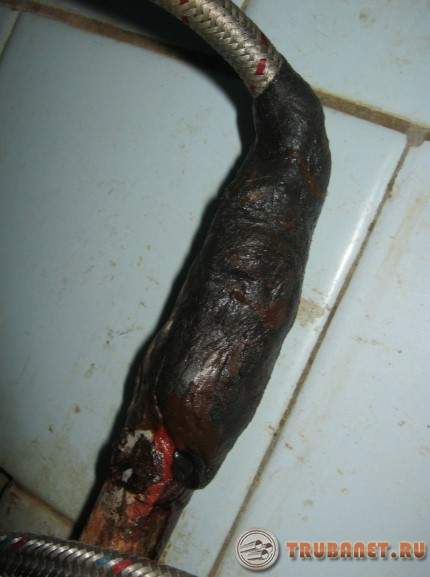
When everything dries up, a composition is applied to the leaking gap. It must completely freeze. This takes approximately ten minutes.
If we consider the sources of water supply in private areas, then wells can be called the most promising. Compared to wells, they contain more water High Quality. It practically does not need cleaning and additional filtration.
 During well operation, the pump and water-lifting pipelines vibrate. This leads to weakening of the joints on the water-lifting mains, and, accordingly, leaks (fistulas) appear. Often this ends in serious accidents.
During well operation, the pump and water-lifting pipelines vibrate. This leads to weakening of the joints on the water-lifting mains, and, accordingly, leaks (fistulas) appear. Often this ends in serious accidents.
The well works with vibration of the lifting pipe due to pumping equipment, and this provokes loosening of the joints. As a result of the appearance of a fistula, the functioning of the well can be completely disrupted.
Video
Many owners of private houses try to carry out repairs and fix such leaks on their own, but experts strongly recommend trusting this to professionals.
Such repairs cost a lot of money, but they are fully justified. Repair work on wells involves a number of complex operations that require special equipment.
For non-professional craftsmen, this work may not be possible. You can clean the well yourself, replace the pump. And holding these events will also require some skill in this matter.
Also, for craftsmen without experience and knowledge, who decide to close the "hole", you need to keep in mind the following information.
Illiterately carried out work can end in fatal results for the well. For example, it is impossible to extract scrap that was accidentally lowered when embedded in a well. And such a loss for amateurs who decide to do everything on their own is very common.
Video: replacing a pressurized faucet
IMPORTANT! Well servicemen say that well flushing is a mandatory annual event. It can be omitted only for wells that are constantly operated.
No less important is the fact that specialists will immediately establish the true cause of the problem. And this will make it possible to close leaks and avoid unnecessary extra costs. Plus, all the work will be done in the shortest possible time.
Now how to close a fistula in a pipe under pressure is clear. Having carefully studied the proposed options, you can quickly fix this unpleasant problem.
This article will discuss how the fistula that has appeared on the pipe is sealed, what methods of sealing exist and is given detailed instructions at the end.
The situation with the appearance of a fistula in a metal riser for heating or water supply occurs quite often, especially in the case of a hot water riser.
The first sign that a fistula has appeared in the pipe and it can "tear" is the appearance on it in some cases of a red growth, which is scientifically called pitting, and popularly - "a pipe in a pipe".
Fistulas occur in pipes both as a result of wear and under the influence of stray currents, but at the moment a fistula appears, the cause fades into the background, and it is much more important to find out how to correct the situation.
Ways to seal a fistula
A fistula that appears in the pipe can be sealed in several ways, each of which requires a preliminary drain of water from the system by closing the stop valve and opening all taps. Consider the main methods of sealing fistulas in more detail.
Bolt termination
Includes the following steps:
- The fistula is expanded with a drill.
- With the help of a marker.
- A bolt is screwed into the resulting hole.
Important: this method is not suitable for old pipes, since they are almost impossible to cut into, attempts to cut usually lead to an increase in the diameter of the leak.
Seal with a temporary bandage
This method is usually used when the fistula of the pipe has an oblong elongated shape.
A bandage with sealing rubber gaskets is applied to the fistula, and materials such as:
- Thick rubber glove;
- Old bicycle tire;
- Medical tourniquet;
- Rubber boot shaft, etc.
Important: the rubber gasket must have a size significantly larger than the size of the fistula.
The gasket is fixed on the pipe using special clamps or bolts.
Sealing with adhesive bandage
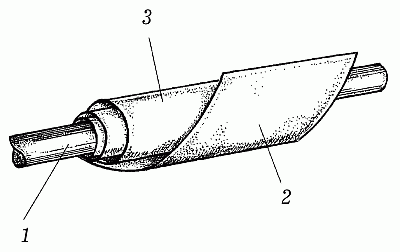
Using an adhesive bandage, the fistula on the pipe is sealed as follows:
- Clean the pipe with a metal brush from dirt, treat its surface with gasoline or acetone and allow to dry for at least 15 minutes.
- Fiberglass is cut into tapes, the dimensions of which depend on the diameter of the pipe so that the length of the tape allows at least 6 layers of winding to be made, and its width exceeds the diameter of the pipe by at least a third.
- The edges of the tape are treated with BF-2 glue, after which one of the sides of the tape is covered with epoxy glue with a spatula.
- Press the spatula firmly so that the tape is saturated with glue.
- Next, the tape is tightly wound on the treated and cleaned surface so that the center of the tape overlaps the damaged area.
- The bandage is pulled together with a metal tape.
- In a day you can use a repaired pipe.
Important: in the case of a pipe located in a cold room with an air temperature not exceeding 17 °, use of the pipe should only be started after 4 days.
Repair by "cold welding" method

For temporary sealing of the resulting fistula, you can also use a special compound called "cold welding":
- The fistula is expanded with a drill.
- The surface of the pipe is cleaned and degreased with acetone.
- After drying the pipe, the composition is applied to it and wait for its complete curing for 10 minutes.
Important: work with epoxy glue and "cold welding" should be done with rubber gloves.
If glue or composition gets on the skin, wipe it with cotton wool moistened with acetone, then wash your hands thoroughly with soap and warm water.
Instructions for closing a fistula
Such preparation can be useful if the fistula occurs at night - this raises the risk of serious flooding while waiting for the mechanic on duty or the emergency team.
In the case of a small fistula, it can be repaired using a standard car clamp:
- A thin strip is cut out of a piece of rubber, the width of which is equal to or 3-4 mm greater than the width of the collar. The length of the tape is measured by winding it around the pipe and cutting off the excess.
- Next, open the clamp and put on the pipe.
- Clamp a little.
- A cut-out rubber gasket is inserted under the clamp and gently brought to the site of fistula formation.
- Cover the fistula and tighten the clamp with a wrench or a screwdriver, depending on the tightening device of the clamp.
As a temporary measure, when there is a very small fistula and there is no clamp at hand, the fistula can be repaired by simply breaking off and inserting the tip of a match into it.
Important: this method should be used only as a last resort - as a result, when the pipes are very old, the fistula may not close, but only increase in diameter.
And even if the fistula is successfully closed with a match, it should be closed as soon as possible with a clamp.
In case of a more serious fistula, it is also desirable to have a more solid collar at the ready (see photo):
- The first step is to turn off and drain the water from the pipes.
- Before installing the clamp, inspect the surface of the pipe. If it is uneven, it is cleaned with sandpaper to prevent water from flowing through the existing roughness.
- Further, as described, a rubber lining is cut out under a more powerful clamp and also installed in place of the fistula.
As can be seen from the article, self-sealing of fistulas in pipes is not particularly difficult, it does not require any special skills and tools. In the event that metal risers are installed in the apartment, it is advisable to always have a pair of clamps and rubber gaskets ready for them so that the appearance of a fistula is not taken by surprise.
The formation of a fistula in a heating or water supply riser mounted from metal pipes is not uncommon. The situation needs to be corrected as soon as possible. Therefore, information on how to close a fistula in the pipe and what methods are available to eliminate it will not be superfluous.
The presence of a reddish-colored build-up on the pipe, which is called pitting, indicates a problem and that the pipeline can break through at any time. Damage occurs as a result of partial destruction or general wear of the line, or under the influence of stray currents. When a fistula is detected, the reason for its appearance no longer matters, the main thing is to eliminate it as soon as possible.
A variety of ways to close the fistula
In order to properly deal with the problem, first of all, you should figure out what a fistula in the pipeline is. This is a hole in the pipe through which water flows out.
You can fix it in several ways:
- with a bolt;
- using a temporary bandage;
- with the use of adhesive bandage;
- cold welding method.
But at the same time, it is imperative to drain the water from the system by closing the valves and opening all available taps.
Seal the hole with a bolt
This option involves a number of steps:
- Expand the fistula in the pipe with a drill.
- Cut the thread with a tap.
- Screw the bolt into the hole formed.
This method cannot be used when the pipes are too old, since it will be impossible to thread them, and attempts to do this usually end in an increase in the size of the leak.
Repair with temporary bandage
This method is used when the fistula on the pipeline has an oblong, elongated appearance.
A bandage is applied to the hole using sealing gaskets, which can be made from such products:
- tourniquet medical;
- thick glove;
- bicycle tire;
- boot shaft, etc.
The main thing is that the size of the rubber gasket significantly exceeds the size of the hole. To fix the bandage on the pipeline, clamps or bolts are used.
Seal with adhesive bandage
The elimination of the fistula by this method is carried out in stages:
- Clean the pipeline from dirt with a metal brush, treat its surface with acetone or gasoline and take 15 minutes to dry.
- Tapes are cut from fiberglass, the length of which depends on the diameter of the pipe - it is necessary that the winding has at least 6 layers. The width of the material must exceed the cross section of the pipeline by at least a third.
- BF-2 glue is applied to the edges of the tape, then one side of it is covered with an epoxy adhesive with a spatula.
- The tool is pressed firmly against the fiberglass so that it is well saturated with glue.
- Then the tape is tightly wound on a previously prepared surface so that its center covers the problem area.
- The bandage is fastened with a metal tape.
- After 24 hours, it is allowed to use the repaired pipeline.
In the case when the system is laid in an unheated room, where the temperature does not exceed 17 degrees, the pipeline can be used only after 4 days.
Cold welding method
Repair of water pipes without welding is carried out using a special composition:
- The hole is enlarged with a drill.
- The surface of the pipeline is degreased and cleaned with acetone.
- When the pipe dries, a product called "cold welding" is applied to it and waited for it to completely harden - usually it takes about 10 minutes.
When using "cold welding" or epoxy adhesive, rubber gloves must be used. If the glue gets on the skin, it must be removed with cotton wool and acetone, and then washed with warm water and soap.
hole filling process
When the system is worn out, it is advisable to prepare several clamps having the same diameter as the pipeline. In addition, you need to stock up on rubber under them. In the event that the fistula of the water pipe appears at night, such preparation will not be superfluous, since the emergency team is unlikely to arrive in a matter of minutes.
If the hole is small, it can be sealed using a conventional vehicle clamp:
- A thin tape is cut from a piece of rubber - its width should be 2-4 millimeters more than the same parameter for the clamp. The length of the cut is measured by wrapping the material around the pipe. The excess piece of tape is cut off.
- The clamp is opened and placed on the pipe, then it is not strongly grabbed.
- A rubber gasket is placed under the clamp and carefully advanced to the place where the hole appears.
- After covering the fistula, the clamp is tightened with a screwdriver or wrench, depending on the features of the device of the protracted product.
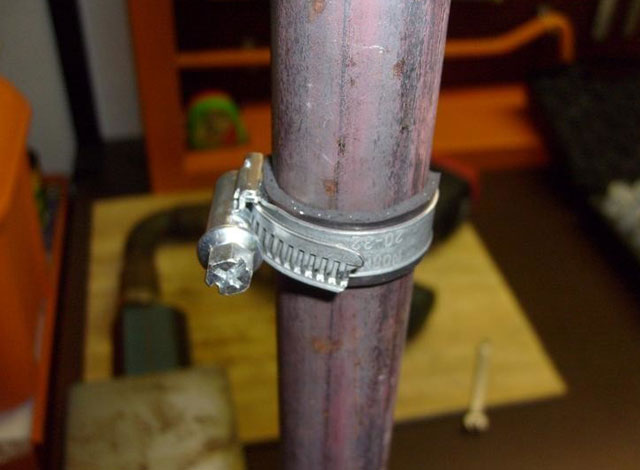
If a fistula of a very small size is found and there is no clamp at hand, the hole can be closed with the end of a match. But this method is rarely used, since it is rarely possible to eliminate a leak in old pipelines - it only increases in size. Even if the gap is successfully sealed with a match, it must be repaired as soon as possible with a clamp.
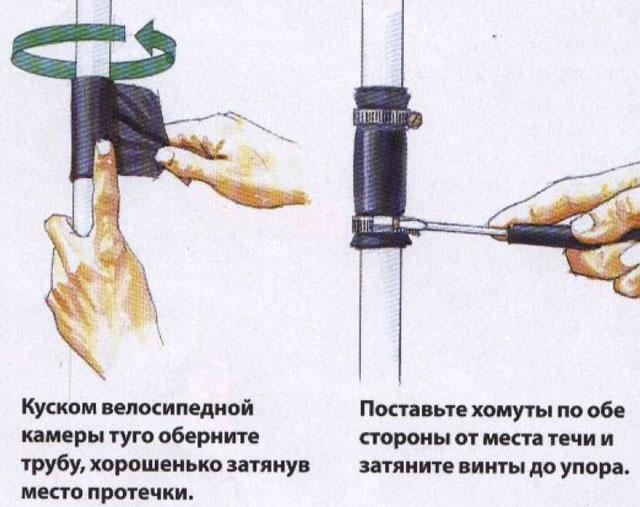
To eliminate a serious fistula on the pipe hot water, you will need a more powerful clamp:
- First of all, turn off the water and drain it from the pipeline.
- Before installing the clamp, carefully inspect the pipe. When its surface is uneven, it should be smoothed out with sandpaper to prevent fluid from flowing through the roughness.
- A rubber lining is cut out under the clamp and placed on the hole.
From the above information, it is clear that it is quite possible to eliminate the fistula in the pipe with your own hands - neither special tools nor special skills are required. If there are metal risers, you need to prepare several clamps and rubber gaskets.
The term "fistula on the pipe" - refers to deformation changes in the form of a through hole in the pipeline. The main reason for the formation of this phenomenon on pipe rolling is considered to be pitting corrosion.
It is a clear signal that the pipeline needs urgent replacement. It is not always possible to perform a full range of pipe repairs with replacement, so it is only partially performed.
At the same time, we must not forget that such measures are temporary, and replacement of sites that have become unusable can still not be avoided. You can use the help of professional craftsmen, or you can repair everything with your own hands.
For termination, you need to prepare the following tools:
- Drill.
- Bolts (set).
- Brush for cleaning rolled metal.
- Bonding agent BV-2, and epoxy bonding type.
- Acetone and gasoline.
- Ketn.
- Putty knife.
Before closing the fistula in the pipe, water is drained from the network. To do this, you need to close the stop valve and open each tap. The system must be free of residual water.
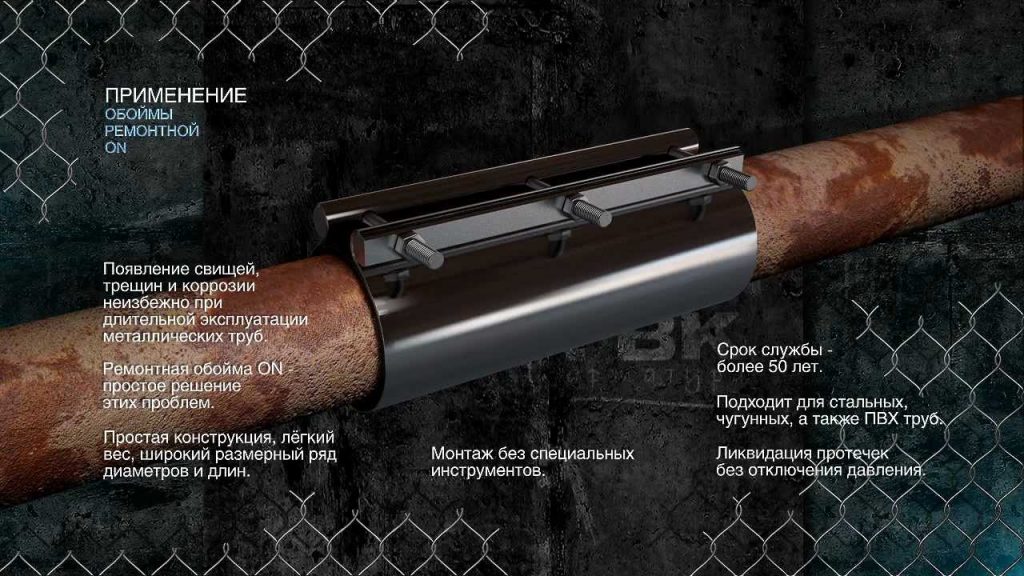
After that, the cleaned area must be degreased with acetone. For the same purpose, you can use gasoline. When sealing, this stage of action is very important.
When applying a bandage to a workpiece with an uneven surface, it is impossible to obtain the most hermetic joint, and all sealing measures will have to be repeated again.
On a well-cleaned surface of the product, it is possible to accurately determine the amount of deformation. And, guided by the information received, they determine a way to further eliminate the deficiency. Fistulas according to the form of education are divided into: point and elongated. Eliminate each of them in different ways.
How is work being done
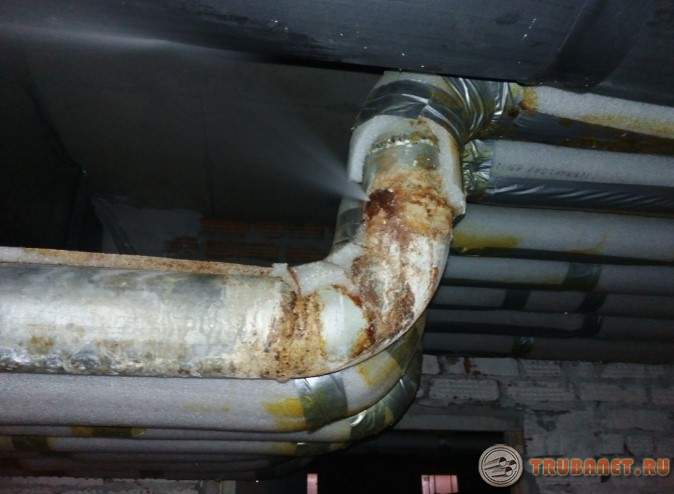 Repair of fistulas on pipes is carried out by the following methods:
Repair of fistulas on pipes is carried out by the following methods:
- Bolt use. In this way they act when it is necessary to close up a small hole. The hole is expanded with a drill, and a thread is cut in the prepared hole. A prepared screw or self-tapping screw is screwed into it. In old highways, this is not recommended. The old age of used metal can lead to a larger hole in the "problem" place.
- Bandage with rubber lining. This method is universal, because it is suitable for all pipe rolling and any kind of water leak. The bandage is selected depending on the dimensions of the leak. It is advised to install a rubber gasket, and a strip of 0.5 cm more than the bandage is cut out of it, and a centimeter less than the circumference of the pipe. It is installed under it and the structure is placed on the fistula zone. If it is not very large, then during the repair it is allowed not to interrupt the water supply.
- Repair with adhesive bandage. First you need to prepare a strip of fiberglass, or an ordinary bandage. The size of the tape should be such that it is enough to wrap the product six times. This tape is soaked with epoxy glue and wrapped so that the leak is located in the center. At the end, the bandage must be secured with a clamp. This pipe network will be able to function only a day after the repair.
- Cold welding termination. This option is temporary. It is intended for small holes. After it, it is better to close up the problem area in one of the more reliable ways. The short duration of the described method is due to the fact that the influence of water and high temperature on liquid welding, leads to its weakening. To repair with cold welding, you just need to apply it to the area of water leakage that has appeared on the product.
Video
Troubleshooting on plastic products
A fistula on a plastic pipe is closed in two ways: threaded and soldering.
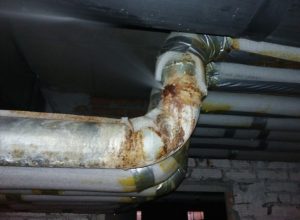
The threaded method can only be used for products where threading is possible. A piece of a pipeline with a fistula that has become unusable is cut off with special scissors.
An insert is prepared from blanks of the required volume. On the plastic materials the thread is cut with a lerkoy. Then, with fittings and couplings, another structure is attached to the pipe network.
Welding on plastic pipes omaterials begins with cutting off the flowing area. After that, a fitting and a workpiece of the appropriate size are prepared.
A heated soldering iron for welding plastic pipes is used to heat the outer edges of the plastic and the inner edges of the fittings. At the final stage of the repair, the prepared pipe is attached with fittings.

This should be done without delay, since plastic tends to solidify instantly, and it is not possible to redo an incorrectly fastened structure a second time.
Repair of copper products
A fistula of a copper pipe is not a rare phenomenon. In construction, copper pipes have been used for a very long time. They are not only suitable for all types of highways, but also have high ductility and resistance to corrosion.
Video
Their service life is not limited, and they will easily stand without breakdowns for the entire period allotted to the house. But, sooner or later, situations arise when these products need to be repaired from a fistula.

For which you need the participation of a specialist. In order not to face the fact of a large fistula, the network should be checked regularly. At the slightest noticed damage, you should immediately deal with the elimination.
Malfunctions in the heating line
Communications do not last forever, and even when using high-quality materials, a fistula can form on the heating pipe.
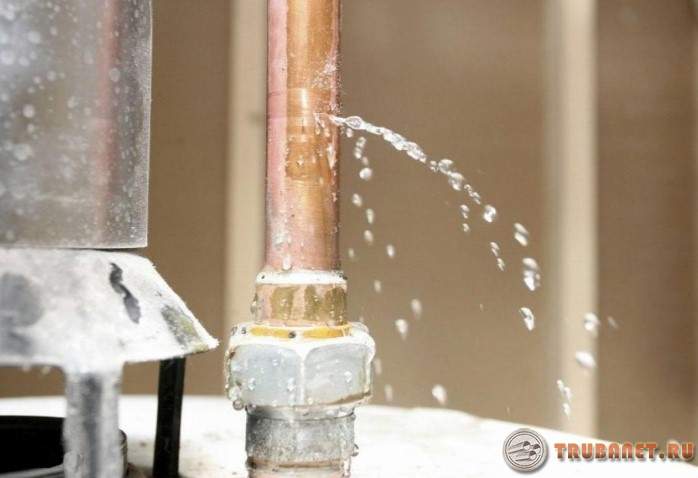
The underlying causes of heating leaks are the following:
- Wear. It is tied up with a long period of use of the heating system. Most often, steel products suffer from leakage.
- Violation of the operating conditions of the heating system. These include temperature and pressure surges, hydraulic shocks.
- Use of goods of dubious quality.
- Poor sealing of joints.
If a leak occurs on the heating pipes, it is necessary to act as follows.
Video
It is necessary to prepare several clamps with rubber seals ( at the same time, the most important thing is not to forget to turn off the water, stop the heating boiler, disconnect the pumps from the power supply and turn off the necessary valves and taps). Repair of pipe assortment in the heating network depends on their type.
For example, steel pipes with a problem with a joint of a threaded variety will require disassembly of the joint and the application of a new winding layer.
If the destruction has formed on the heating pipe itself, then the problem area will have to be welded using gas or electric welding.
If a copper pipe is leaking, then it must also be welded. But, welding work with copper is quite complicated, therefore, it is better to entrust them to specialists.
If the metal-plastic pipelines of the heating system are leaking, then it will be necessary to replace the entire area where the leak has formed. On this type of pipe rolling, it is most often formed at joints of the compressor type.
On a plastic heating pipe, the problem is solved in this way. This is a replacement for the whole area. Polypropylene soldering is advised to be carried out in accordance with all the standards of this work. Any errors can cause the joint to fall apart after a very short time.
Video
IMPORTANT! When acting with plastic products making changes to the wiring diagram is prohibited.
Features of metal pipelines
If we are talking about how to weld a fistula in a pipe, which is large, then the only recommended way out is a complete replacement.
And, if the fistula is small, then here are a few options for action. But, these recommendations can only be applied in case of leaks of metal assortment pipes.
Video
Option 1. In this case, the defect is eliminated with a medical bandage and cement for sealing. First, a solution of cement and water is diluted. 15-20 strips are cut from the bandage, 20 cm long. The tapes are moistened in the solution and wrapped around the line. The result is something similar to a cocoon. A cement mortar is applied on top of it. All this should dry for 24 hours, and then the pipe network can be launched.
Option 2. Pieces of rubber to make repairs. A strip is cut out of rubber, slightly longer than the circumference of the pipe. The problem area is tightly fitted with this strip, which is then fixed. For reliability, it must be covered with a bandage with cement, as described in the previous method.
Option 3. Bandage and edible salt. So they cover the small "gaps" between the joints. To do this, the place of the leak is wrapped with a bandage mixed with salt. Salt, when dissolved, fixes micro-leakage. But it is impossible to apply this method for large formations; one should act differently.
Defects in water supply networks
How to close a fistula in a water pipe is often of interest. Unfortunately, plumbing leaks are a very common occurrence.
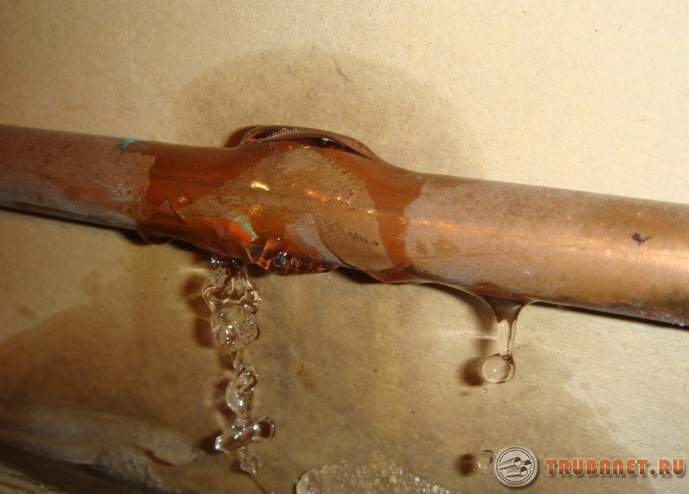 In this case, it is possible to seal the place of water flow with such devices as a clamp, cold welding or any other folk methods.
In this case, it is possible to seal the place of water flow with such devices as a clamp, cold welding or any other folk methods.
The condition of the plumbing system must be constantly checked. If the workpieces have served for a long time, and it is not possible to quickly replace them, then it is necessary to prepare several clamps for stock in order to make repairs, because water leakage in such products can occur at any time.
Video
If rust smudges appear on the water supply and paint swells in places on the nozzles, this is a signal that pitting is about to appear.
IMPORTANT! Fistula in the pipe cold water under a layer of paint is not as dangerous as in the analogue with hot water. If the water from under the removed paint during the repair from the nozzle breaks through with a fountain, it can cause serious burns to a person.
Leak in sewer pipes
Considering the question of how to eliminate the fistula in the sewer pipe, it should be noted that to cope with this task a little harder than to repair water leaks at the joints.
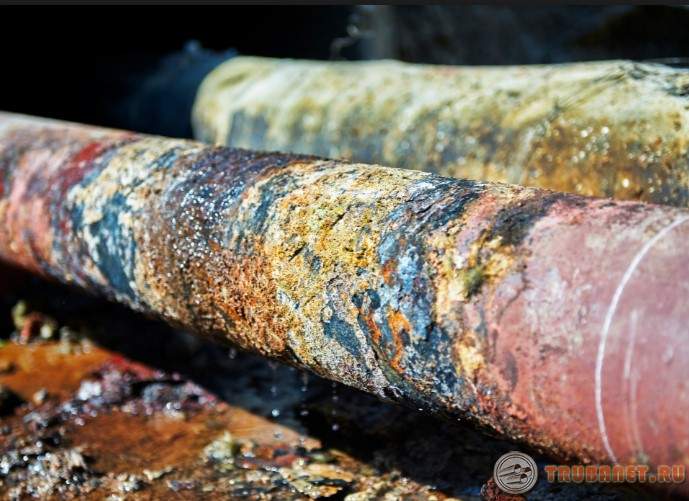
At the beginning of embedding, an assessment of the defect and the strength of the workpiece will be required. Small leaks can be eliminated by plugs for this type of tube rolling. You can also try the repair method - winding with gauze impregnated with epoxy resin.
The option with a rubber gasket fixed with a clamp will help temporarily seal the water leak. It and a clamp for repair can be purchased at any store. building materials. Also, its gasket can be fixed using a wire.
Longitudinal cracks and chips on the pipe are easy to eliminate with sealant. To do this, the fistula is slightly enlarged, degreased and dried.
After that, a sealant is applied to the area. Metal materials in the sewer from water leaks are sealed with cold welding.
Seal a leak with your own hands
Water leaks occur at any time, so sealing fistulas in pipes with your own hands is a very important skill.
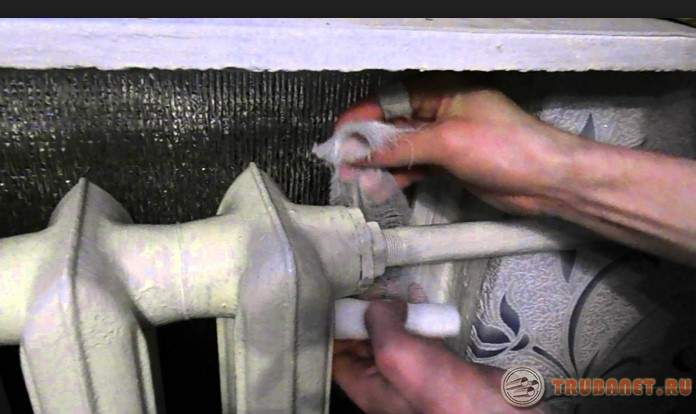
For very urgent sealing of the fistula, it is recommended to use a clamp. It is a metal screed. And you need to apply the clamp in this way:
- The plumbing system is closed.
- Bolts are unscrewed on the clamp, and it is wrapped around the water leakage area.
- The nuts on the clamp are tightened with an adjustable wrench, while the pipe itself is held with a pipe wrench. Without support, which will entail additional water leaks and repair costs.
Video
Termination methods using a lock nut and using a rubber band also turn out to be effective. In general, it is not difficult to repair and eliminate a fistula on a pipe.
If there is no self-confidence, then it is worth inviting professional masters. And if the fistula was closed in one of the temporary ways, then you should worry about how to complete a full pipe repair in the near future.



